
Eriogonum brachypodum is a species of wild buckwheat known by the common name Parry's buckwheat. This annual herb is native to the southwestern United States from California to Utah and especially the Mojave Desert. It grows in sandy and gravelly substrates. It has a skeletonlike spindly stem which branches many times. It can grow 5 to 50 centimeters in height and up to a meter in width. There is an array of rounded, dark-colored leaves around the base. Leaves are a few centimeters long and fuzzy on the undersides. Most of the plant is actually the spreading inflorescence. At intervals on the otherwise naked branches hang tiny clusters of glandular flowers a few millimeters wide in involucres of bell-shaped bracts. Each flower is less than three millimeters wide.

Lepidium flavum is a species of flowering plant in the mustard family known by the common name yellow pepperweed. It is native to California, Nevada, and Baja California, where it grows in the Sonoran and Mojave Deserts. The species epithet flavum is Latin for yellow and indicates its flower colour.
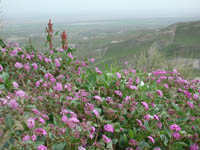
Abronia pogonantha is a species of flowering plant in the four o'clock family (Nyctaginaceae) known by the common name Mojave sand-verbena. It is native to California and Nevada, where it grows in the Mojave Desert, adjacent hills and mountains, and parts of the San Joaquin Valley in the Central Valley.

Eriocoma parishii is a species of grass known by the common name Parish's needlegrass.

Eremogone macradenia is a species of flowering plant in the family Caryophyllaceae known by the common names Mojave sandwort and desert sandwort.

Astragalus jaegerianus is a rare species of milkvetch known by the common name Lane Mountain milkvetch. The plant was named for the biologist Edmund Jaeger, who first documented it in 1939.

Astragalus layneae is a species of milkvetch known by the common name widow's milkvetch. It is native to the Mojave Desert and surrounding mountain ridges in California and Nevada.
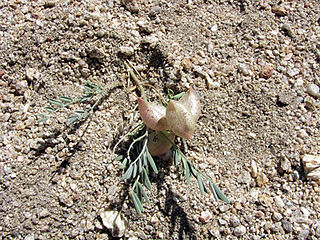
Astragalus nutans is a species of milkvetch known by the common name Providence Mountains milkvetch.

Brickellia desertorum is a species of flowering plant in the family Asteraceae known by the common names desert brickellbush and desert brickellia. It is native to Mexico, Central America, the West Indies, and the southwestern United States.

Caulanthus glaucus is a species of flowering plant in the family Brassicaceae known by the common names glaucous wild cabbage, bigleaf wildcabbage, and limestone jewelflower.

Cirsium mohavense is a species of thistle known by the common names virgin thistle and Mojave thistle. It is native to the southwestern United States, where it grows in moist areas in otherwise dry habitat, such as desert springs. It is most common in the Mojave Desert, found also in the southern Great Basin and other nearby regions of California, Nevada, western Arizona, and southwestern Utah.

Aliciella leptomeria is a species of flowering plant in the phlox family known by the common names sand gilia and Great Basin gilia. It is native to the Western United States, where it grows in many types of habitat, such as the sagebrush of the Great Basin and in the Mojave Desert.
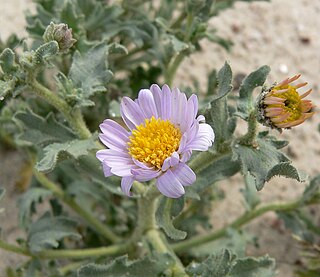
Leucosyris arida is an annual plant in the family Asteraceae, known by the common names arid tansyaster, desert tansyaster, and Silver Lake daisy. It is native to the very arid deserts of northern Mexico and the southwestern United States, and usually looks straggly and not very attractive. But in years with very heavy rainfall, it fills out and becomes rounded and bush like.
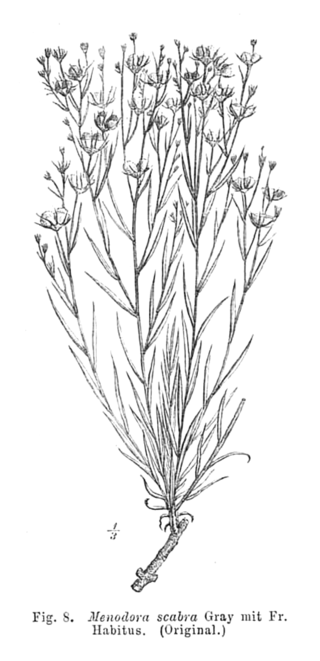
Menodora scabra is broom-like shrub in the Olive Family (Oleaceae), known by the common name rough menodora or broom twinberry. It is a popular desert garden plant.
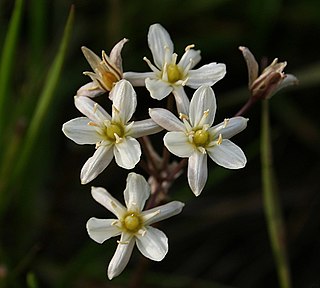
Muilla maritima is a species of flowering plant known by the common names sea muilla and common muilla. It is native to California and Baja California, where it grows in many types of habitats from the coast to the Mojave Desert and Sierra Nevada foothills and other inland mountains, in grassland, woodland, desert, and forest floras. It is a perennial plant growing from a corm and producing an erect flowering stem up to half a meter tall. The onion-like leaves at the base of the stem may be 60 centimeters long. The flowering stem bears an umbel-shaped array of many flowers on pedicels up to 5 centimeters long. Each flower has six tepals which are green-tinged white in color with brownish midribs and no more than 6 millimeters in length. At the center of the flower are six erect stamens with blue, green, or purplish anthers.
Nama depressum, commonly known as depressed fiddleleaf, is a species of flowering plant in the borage family. It is native to Nevada and eastern California, where it grows in dry desert and mountain habitat, including the Mojave Desert.

Phacelia nashiana is a species of phacelia known by the common name Charlotte's phacelia. It is endemic to California, where it is known only from the ecotone where the lower Sierra Nevada and Tehachapi Mountains transition into the Mojave Desert. It grows in scrub and woodland and on granite mountain slopes.

Psorothamnus arborescens is a species of flowering plant in the legume family known by the common name Mojave indigo bush.

Senecio mohavensis, known by the common name Mojave ragwort, is a species of flowering plant in the aster family.
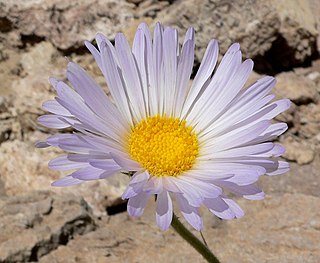
Xylorhiza tortifolia is a species of flowering plant in the family Asteraceae, known by the common names Mojave-aster and Mojave woodyaster.



















